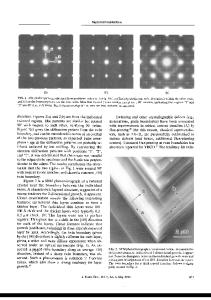Morphology and mesopores in photoelectrochemically active LaTiO 2 N single crystals
- PDF / 407,909 Bytes
- 6 Pages / 584.957 x 782.986 pts Page_size
- 92 Downloads / 833 Views
The mesoporous network within photocatalytically and photoelectrochemically active LaTiO2N (LTON) single crystals was investigated by electron microscopy techniques including electron diffraction and scanning transmission electron microscopy imaging. The perovskite-related oxynitride particles were obtained by thermal ammonolysis from monocrystalline micrometersized La2Ti2O7 (LTO) particles grown by flux-assisted solid state synthesis. Special attention was paid to the crystal transformation from the monoclinic layered LTO to the orthorhombic perovskite-related LTON within the monocrystalline particles. A detailed analysis of pore directions and pore sizes with respect to the LTON particle shape was performed. The pore formation mechanism taking place during thermal ammonolysis was discussed. Based on the mechanistic understanding of the transformation from the oxide to the oxynitride, a further extension of the mesoporous network toward higher surface areas was proposed for improved photoelectrochemical activity of oxynitride particles, while high crystallinity and particle sizes in the micrometer range continue to enable efficient charge transport.
I. INTRODUCTION
Mesoporous single crystals have been a matter of discussion in the last years in the context of solar hydrogen generation, since it is expected that this material class can contribute significantly to the improved design of highly efficient solar cell devices.1 Especially in photocatalysis or photoelectrochemistry, high surface area and good charge transport properties are central prerequisites for enhanced device performance.2,3 The best conductivity for a given material is usually provided by defect free structures, such as large single crystals, but the specific surface area is small. High surface area, however, is reached best by an agglomeration of nanoparticles. In consequence, the conductivity is low because of multiple grain or particle boundaries. One possibility to achieve performance improvement consists in the fabrication of nanostructured thin films with high crystalline quality, where the surface is enhanced, but the charge transport is not affected. The effects of different kinds of nanostructuring procedures on the photoelectrochemical performance, in comparison to single crystals or nanoparticles, have been studied extensively on the example of Fe2O3 electrodes by Kay et al.,4 and have been summarized by Osterloh.5 Finding a better trade-off between large surface area and undiminished charge transport properties is still considered as one of the most important Contributing Editor: Heli Wang a) Address all correspondence to this author. e-mail: [email protected] DOI: 10.1557/jmr.2016.9
parameters to obtain better device performance.3,6,7 Recently a new concept has been proposed: the synthesis of micrometer-sized mesoporous single crystals.8 The superior conductivity of mesoporous TiO2 single crystals in comparison to nanocrystalline material has been shown as well as their increased surface area. Following this concept, we have investig
Data Loading...










